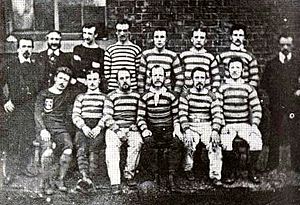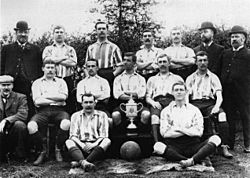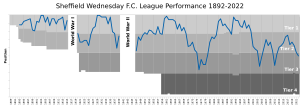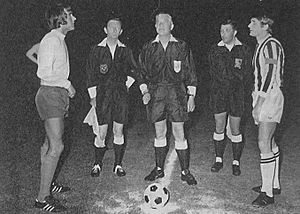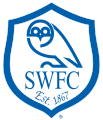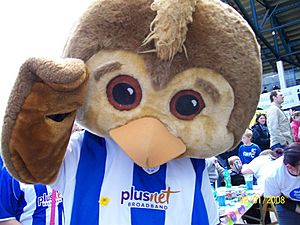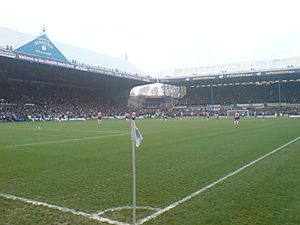Sheffield Wednesday F.C. facts for kids
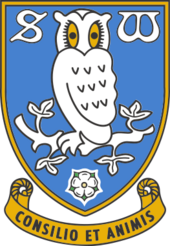 |
||||
| Full name | Sheffield Wednesday Football Club | |||
|---|---|---|---|---|
| Nickname(s) | The Owls | |||
| Short name | SWFC | |||
| Founded | 4 September 1867 as The Wednesday | |||
| Ground | Hillsborough Stadium | |||
| Capacity | 39,732 | |||
| Owner | Dejphon Chansiri | |||
| Chairman | Dejphon Chansiri | |||
| Manager | Danny Röhl | |||
| League | Championship | |||
| 2018–19 | Championship, 12th of 24 | |||
|
||||
Sheffield Wednesday Football Club is a professional football team from Sheffield, England. They are known as "The Owls" and play in the Championship, which is the second highest league in English football.
The club started in 1867 from a cricket club called The Wednesday Cricket Club. They were first known as The Wednesday Football Club until 1929. Sheffield Wednesday is one of the oldest football clubs still playing today. They are also the second-oldest professional football club in England.
The Owls have won many important trophies. These include four league titles, three FA Cups, one League Cup, and one FA Community Shield. They have also played in European competitions four times. In 1991, they won the Football League Cup while playing in the second division. They are still the last team outside the top league to win a major English trophy.
Since 1899, Sheffield Wednesday has played their home games at Hillsborough Stadium. This stadium can hold almost 40,000 fans. Their biggest rivals are Sheffield United, and their matches are called the Steel City derby.
Contents
The History of Sheffield Wednesday
How the Club Began (1867–1889)
The Wednesday Cricket Club was likely formed around 1820. They were called "The Wednesday" because the founding members had Wednesdays off work. The cricket club played at different grounds, including Bramall Lane.
In 1867, members decided to form a football club to stay fit in winter. More than 60 members joined the new team right away. Their first match was on October 19, 1867, which they won.
Football quickly became more popular than cricket. In 1882, the football and cricket parts of the club separated. On February 1, 1868, Wednesday played their first competitive football match. They won the Cromwell Cup, a special tournament for new clubs. They beat the Garrick club in the final. This was one of the first times a game was decided by a "golden goal".
Charles Clegg was a very important person in the club's early days. He joined in 1867 and later became the club's chairman. He also became president of the Football Association. Clegg played for England in the first-ever international football match in 1872.
In 1876, the club got James Lang, a player from Scotland. He is now known as the first professional football player in England. With Lang, Wednesday became one of the strongest teams in the area. They won the first Sheffield FA Challenge Cup in 1877.
The club officially stayed amateur for a while. But by 1887, many of their best players were leaving for clubs that paid them. So, the club decided to start paying its players.
Becoming Professional and Winning Trophies (1889–1939)
After becoming professional, the club moved to a new ground called Olive Grove. In 1889, they helped start the Football Alliance and were its first champions. They also reached the 1890 FA Cup final but lost to Blackburn Rovers. In 1892, they joined The Football League. They won the FA Cup for the first time in 1896, beating Wolverhampton Wanderers 2-1.
Because of railway expansion, the club needed a new home for the 1899–1900 season. They bought land in Owlerton and built a new stadium, now called Hillsborough Stadium. This secured the club's future for many years. Wednesday had a great decade, winning the League in 1902–03 and 1903–04. They won the FA Cup again in 1907, beating Everton 2-1.
Football stopped during World War I (1915-1919). Wednesday played in regional leagues until competitive football returned. They were relegated from the top league in 1920. They returned in 1926 and won the League title in 1928–29. They continued to be a top team until 1936. The team won the FA Cup for the third time in 1935. When World War II began, the club again played in non-competitive leagues until 1946.
Ups and Downs (1945–1959)
The 1950s were a time of "yo-yo" years for Wednesday. They struggled to stay in the top league. They were promoted in 1950 but were relegated three times. However, each time they were relegated, they won the Second Division the next season to return to the top flight. The decade ended well, with the team finishing in the top half of the First Division.
Back at the Top and Title Contenders (1959–1970)
In 1961, the club almost won the league title, finishing second behind Tottenham Hotspur. This is still the club's highest league finish since World War II. In 1966, the club reached its fifth FA Cup final but lost 3-2 to Everton, even after leading 2-0.
Tough Times and Comeback (1970–1984)
Wednesday was relegated at the end of the 1969–70 season. This started a difficult period for the club. They dropped to the Third Division for the first time. In 1976, they almost fell to the Fourth Division.
Things started to improve when Jack Charlton became manager in 1977. Charlton led the Owls back to the Second Division in 1980. Then, Howard Wilkinson took over and led the club back to the top league in 1984, after 14 years away.
Premier League and European Football (1984–2000)
Wednesday did well after returning to the top league. They finished 8th in their first season and 5th the next. This meant they qualified for European football. However, English clubs were banned from European competitions at that time due to the Heysel Stadium disaster.
On April 15, 1989, the club's stadium was the site of a terrible tragedy. At an FA Cup semi-final, 97 Liverpool fans were fatally crushed. This event, known as the Hillsborough disaster, led to major changes in all top English stadiums. Terraces were replaced with seats, and perimeter fences were removed.
In 1989–90, Sheffield Wednesday was relegated again. But they quickly won promotion back to the top league. The highlight of that season was winning the League Cup final against Manchester United. Midfielder John Sheridan scored the only goal. This was the club's first major trophy since 1935. As of 2025, they are still the last team to win a major English trophy while not in the top division.
Trevor Francis became manager in 1991. Wednesday finished third in the First Division in 1991–92. This earned them a spot in the UEFA Cup and made them a founding member of the new FA Premier League.
The 1992–93 season was very exciting. Wednesday finished seventh in the Premier League. They also reached the finals of both the FA Cup and the League Cup. However, they lost to Arsenal in both finals. Even so, this season showed Sheffield Wednesday was a top club. Chris Waddle was named Footballer of the Year.
Francis was replaced by David Pleat in 1995. Pleat's first season was tough, but in 1996–97, the Owls started strong, topping the league after four games. They finished seventh that season. Pleat was later sacked, and Ron Atkinson briefly returned to help the club avoid relegation.
In 1998, Danny Wilson became the new manager. His first season saw the team finish 12th in the Premier League.
Recent Highs and Lows (2000–Present)
In the 1999–2000 season, the club had expensive players but struggled. Danny Wilson was sacked, and the team was relegated to the First Division.
The club faced financial problems. In 2003, they were relegated again, this time to the Second Division. They spent two years there before winning the 2005 play-off final against Hartlepool United to return to the Championship. However, financial issues continued, and five years later, they were relegated to League One again.
Between 2010 and 2011, Sheffield Wednesday faced serious threats to its existence due to unpaid taxes. In November 2010, businessman Milan Mandarić bought the club, saving it.

In May 2012, under manager Dave Jones, the team won promotion back to the Championship.
In 2014, Thai businessman Dejphon Chansiri bought the club. He aimed for Premier League promotion. Under coach Carlos Carvalhal, Wednesday reached the play-offs in the 2015–16 season but lost the final to Hull City. They made the play-offs again the next season but lost in the semi-finals.
The club struggled in the following seasons. Managers changed frequently, including Jos Luhukay, Steve Bruce, Garry Monk, and Tony Pulis. In 2020, Sheffield Wednesday was penalized points for breaking league spending rules. In March 2021, Darren Moore became manager, but the team was relegated to League One at the end of the season.
After one season in League One, Wednesday finished third in 2022–23. They had an amazing comeback in the play-off semi-finals, winning 5-1 after losing the first leg 4-0. They then won promotion back to the Championship by beating Barnsley in the 2023 play-off final.
After Moore left, Xisco Muñoz became manager but was sacked after 12 winless games. Danny Röhl took over and helped the team avoid relegation on the final day of the season. The club faced financial challenges, including delayed player payments and a ban on transfers for the summer 2025 and 2026 transfer windows.
Club Identity: Nickname, Kits, and Crest
What is the Club's Nickname?
In their early years, the club was called "The Blades." This name was used for any sports team from Sheffield, a city famous for making knives. However, Wednesday's rivals, Sheffield United, now use this nickname.
The club's nickname changed to "The Owls" around 1912. This happened when a player gave the club an owl mascot. The name stuck, and the owl became a symbol for the club.
What Do the Kits Look Like?
|
|
| The Wednesday's home shirt of 1871. It is assumed that these were the original colours used by the team. |
Sheffield Wednesday has always played home games in blue and white shirts. Usually, these shirts have vertical stripes. But there have been some changes over the years. For example, in 1871, their colors were blue and white hoops. Between 1965 and 1973, they wore a blue shirt with white sleeves. Their socks have mostly been black, blue, or white.
The away kits (worn for games not at home) have changed a lot. White was often the second choice. But the club has also used yellow, black, silver, green, and orange for their away strips.
Understanding the Club Crest
Since 1912, the owl has been a key part of the club's identity. The first club crest was introduced in 1956. It showed an owl on a branch. It also included the White Rose of York (for Yorkshire) and sheaves (bundles of grain) for Sheffield. The club's Latin motto, Consilio et Animis, was also on the crest. This means "By Wisdom and Courage."
The crest changed in 1970 to a simpler design. This simpler owl logo was used until 1995. Then, a design similar to the original 1956 crest was brought back. It still had an owl on a branch, but with a new look. The words Sheffield Wednesday and Hillsborough were added.
In 1999, the simpler owl logo returned. In 2016, the club's owner, Dejphon Chansiri, changed the crest again. He chose a design similar to the 1956 badge.
Club Mascots
Sheffield Wednesday has had several owl-themed mascots over the years. The main mascot is Ozzie Owl. Later, Baz and Ollie were added. In 2006, they were replaced by Barney Owl, who looked cuter. Ozzie Owl was brought back in 2009 as the main mascot. Today, the mascots are Ozzie and Barney Owl. Ollie Owl also helps with the club's work in the local community.
The Stadium: Hillsborough
Where Did They Play Before?
Wednesday first played at Highfield. They moved several times before finding a permanent home. Other places included Myrtle Road and Hunter's Bar. Big matches were played at Sheaf House or Bramall Lane. Sheffield Wednesday's first permanent home was Olive Grove. The first game there was a 4-4 draw with Blackburn Rovers in 1887. The club had to move in 1899 because of railway expansion.
Hillsborough Stadium Today
Since 1899, Wednesday has played at Hillsborough Stadium in Owlerton. The stadium was first called Owlerton Stadium. In 1914, it became part of the Hillsborough area, and the name changed. Hillsborough has 39,732 seats, making it one of the largest stadiums in England.
The stadium has hosted World Cup games in 1966 and European Championships in 1996. It has also hosted 27 FA Cup semi-finals. The Kop stand at Hillsborough was once the largest covered stand in Europe. Queen Elizabeth II reopened it in 1986.
On April 15, 1989, a tragic event happened at Hillsborough during an FA Cup semi-final. This event, known as the Hillsborough disaster, led to 97 Liverpool fans losing their lives due to overcrowding. This tragedy led to major safety changes in all football stadiums in England. A memorial for the victims stands outside the stadium.
Fans and Supporters
When the club moved to Owlerton in 1899, it was a risk because it was far from the city center. But loyal fans continued to travel, and the club has been well-supported ever since.
The highest average number of fans at games was 42,530 in the 1952–53 season. The lowest was 10,643 in 1978–79. In 1992, Wednesday was the fourth most supported team in England. Even after being relegated from the Premier League in 2000, they still often have crowds of over 20,000. In 2006, they were the best-supported club outside the top league.
At the 2005 play-off final, over 39,000 Wednesday fans went to the Millennium Stadium. In 2016, over 38,000 fans went to Wembley for a play-off final.
Fans have created many fanzines (fan magazines) over the years. Some names include Just Another Wednesday and War of the Monster Trucks. There are also many online message boards where fans discuss the club.
Rivalries: The Steel City Derby
Sheffield Wednesday's biggest rivals are their city neighbors, Sheffield United. Games between these two clubs are called Steel City derbies. This name comes from Sheffield's famous steel industry.
Sheffield United was formed in 1889. They started playing at Bramall Lane, which used to be Wednesday's ground. United also took Wednesday's old nickname, "The Blades." The first derby game was on December 15, 1890, and Wednesday won 2-1.
A famous derby match was the 1993 FA Cup semi-final at Wembley. Over 75,000 fans watched Wednesday beat United 2-1 after extra time.
Besides Sheffield United, Wednesday fans also see other Yorkshire teams as rivals. These include Leeds United, Barnsley, Rotherham United, and Doncaster Rovers.
European Competitions
Sheffield Wednesday has played in European competitions several times.
| Season | Competition | Round | Opponent | Home | Away | Aggregate |
|---|---|---|---|---|---|---|
| 1961–62 | Inter-Cities Fairs Cup (UEFA Europa League) |
Last 32 | 5–2 | 2–4 | 7–6 | |
| Last 16 | 4–0 | 0–1 | 4–1 | |||
| Quarter-final | 3–2 | 0–2 | 3–4 | |||
| 1963–64 | Inter-Cities Fairs Cup (UEFA Europa League) |
First round | 4–1 | 4–1 | 8–2 | |
| Second round | 1–2 | 2–3 | 3–5 | |||
| 1986–87 | UEFA Cup (UEFA Europa League) |
English clubs were banned from competition at this time. | ||||
| 1991–92 | UEFA Cup (UEFA Europa League) |
English clubs were banned from competition at this time. | ||||
| 1992–93 | UEFA Cup (UEFA Europa League) |
First round | 8–1 | 2–1 | 10–2 | |
| Second round | 2–2 | 1–3 | 3–5 | |||
| 1995–96 | UEFA Intertoto Cup | Group stage | N/A | 0–1 | N/A | |
| 3–2 | N/A | N/A | ||||
| N/A | 1–1 | N/A | ||||
| 3–1 | N/A | N/A | ||||
Players and Staff
Current First Team Players
|
|
First Team Staff
| Role | Name |
|---|---|
| Manager | |
| Performance manager | |
| Assistant head coach | |
| Assistant coach | |
| Coach | |
| Coach | Andy Parslow |
| Set piece analyst | Ben King |
| Club doctor | Taaha Nadeem |
| Head physio | Antonio Quintela |
| Physiotherapist | Dean Taylor |
| Physiotherapist | Paul Teather |
| Soft tissue therapist | Dominic Millward |
| Masseur | Ben Parker |
| Head of sports science | Rob Lee |
| Sports scientist | Chris Brealey |
| Strength and conditioning coach | Ryan McMahon |
| Performance analyst | Richard Stirrup |
| Head kitman | Ash Holland |
Club Leadership
| Role | Name |
|---|---|
| Chairman | Dejphon Chansiri |
| Finance director | John Redgate |
Club Records and Statistics
Wednesday's biggest win ever was 12-0 against Halliwell in the FA Cup in 1891. Their biggest league win was 9-1 against Birmingham in 1930. Their heaviest defeat was 10-0 against Aston Villa in 1912.
The most goals the club scored in one season was 106 in the 1958–59 season. In the 2022–23 season, they earned their highest league points total with 96 points.
The highest number of fans at a home game was 72,841. This happened in an FA Cup match against Manchester City in 1934.
The fastest sending off in British league football happened to Sheffield Wednesday goalkeeper Kevin Pressman. He was sent off after only 13 seconds in a game in 2000. The fastest shot ever recorded in the Premier League was by David Hirst in 1996. His shot hit the bar at 114 miles per hour.
Club Honours (Trophies Won)
Source:
League Titles
- First Division (top league)
- Champions: 1902–03, 1903–04, 1928–29, 1929–30
- Second Division (second league)
- Champions: 1899–1900, 1925–26, 1951–52, 1955–56, 1958–59
- Runners-up: 1949–50, 1983–84
- Promoted: 1990–91
- Third Division / League One (third league)
- Runners-up: 2011–12
- Promoted: 1979–80
- Play-off winners: 2005, 2023
- Football Alliance
- Champions: 1889–90
Cup Competitions
- FA Cup
- Winners: 1895–96, 1906–07, 1934–35
- Runners-up: 1889–90, 1965–66, 1992–93
- Football League Cup
- Winners: 1990–91
- Runners-up: 1992–93
- FA Charity Shield
- Winners: 1935
- Runners-up: 1930
See also
 In Spanish: Sheffield Wednesday Football Club para niños
In Spanish: Sheffield Wednesday Football Club para niños



